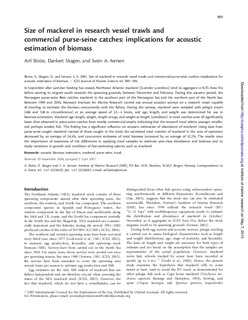| dc.description.abstract | In September after summer feeding has ceased, Northeast Atlantic mackerel (Scomber scombrus) tend to aggregate in ICES Area IVa before starting to migrate south towards the spawning grounds, between December and February. During this autumn period, the Norwegian purse-seine fleet catches mackerel in the southern part of the Norwegian Sea and the northern part of the North Sea. Between 1999 and 2005, Norway’s Institute for Marine Research carried out annual acoustic surveys on a research vessel capable of trawling, to estimate the biomass concurrently with the fishery. During the surveys, mackerel were sampled with pelagic trawls (486 and 538 m circumference) at an average speed of 3.5–4 knots, and age, length, and weight was determined for use in biomass estimation. Mackerel age, length, weight, length-at-age, and weight-at-length (condition) in trawl catches were all significantly lower than observed in purse-seine catches from nearby commercial vessels, indicating that the research trawl selects younger, smaller, and perhaps weaker, fish. This finding has a significant influence on acoustic estimation of abundance of mackerel. Using data from purse-seine-caught mackerel instead of those caught in the trawl, the estimated total number of mackerel in the area of operation decreased by an average of 26.4%, and concurrent estimates of total biomass increased by an average of 32.2%. The results raise the importance of awareness of the differences in applying trawl samples to estimate year-class abundance and biomass and to study variations in growth and condition of fast-swimming species such as mackerel. | en_US |
